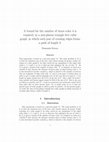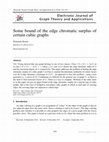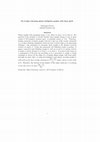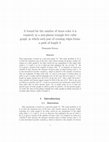Papers by diamantis koreas
This paper deals with the following problem. "Among all proper 4-edge colorings of a cubic graph ... more This paper deals with the following problem. "Among all proper 4-edge colorings of a cubic graph G, with colors 1, 2, 3 and 4, find one that minimize the use of color 4." In a previous paper [1] this problem is faced using the notion of the "position" of crossing points (or crossing edges) and the notion of the "connection by bicolors paths". Moreover, a bound is given of the number of times color 4 is required, in terms of the distance between the crossing points in the drawing of the graph. In the present paper, we improve this bound for specific types of cubic graphs.
This paper deals with the following problem. "Among all proper 4-edge colorings of a cubic graph ... more This paper deals with the following problem. "Among all proper 4-edge colorings of a cubic graph G, with colors 1, 2, 3 and 4, find one that minimize the use of color 4." In a previous paper [1] this problem is faced using the notion of the "position" of crossing points (or crossing edges) and the notion of the "connection by bicolors paths". Moreover, a bound is given of the number of times color 4 is required, in terms of the distance between the crossing points in the drawing of the graph. In the present paper, we improve this bound for specific types of cubic graphs.
This paper deals with the following problem. "Among all proper 4-edge colorings of a cubic graph ... more This paper deals with the following problem. "Among all proper 4-edge colorings of a cubic graph G, with colors 1, 2, 3 and 4, find one that minimize the use of color 4." In a previous paper [1] this problem is faced using the notion of the "position" of crossing points (or crossing edges) and the notion of the "connection by bicolors paths". Moreover, a bound is given of the number of times color 4 is required, in terms of the distance between the crossing points in the drawing of the graph. In the present paper, we improve this bound for specific types of cubic graphs.

This manuscript demonstrates the concept of "bicolor connections" as it is desc... more This manuscript demonstrates the concept of "bicolor connections" as it is described in [1] and gives ideas for further uses of it. The main problem in [1] is to find the minimum size of the four color classes among all proper 4-edge colorings of a cubic graph G. In other words for any assignment to the edges with colors 1, 2, 3 and 4, we try to find one that minimize the use of color "4". The number t of times that color 4 is required in a 4-edge coloring of a non-planar cubic and bridgeless graph G is related to the existence of bicolor paths between the pairs of its crossing edges. In [1] is given a bound for the general case of a cubic and bridgeless graph G. On the other hand in [2] are given bounds for t in the case that we have some special types of cubic graphs. The use of "bicolor connection" as in [2] can be extended to subgraphs of G or to subcubic graphs. In this paper we discuss some ideas for the subcubic graphs and we modify the bound in [1] for subgraphs of graph G having l connected edges with the rest graph.

This manuscript is based on a previous paper [1]. The main problem in [1] is to find the minimum ... more This manuscript is based on a previous paper [1]. The main problem in [1] is to find the minimum size of the four color classes among all proper 4-edge colorings of a cubic graph G. In other words for any assignment to the edges with colors 1, 2, 3 and 4, we try to find one that minimize the use of color “4". In [1] is given a bound of the number of times color “4" is required, in terms of a variable D that denotes the distance between pairs of edges having color 4. It is also introduced another variable q, which is related to the number of vertices that are endpoints of edges with color “4" and it is necessary to delete them, in order to get a 3-edge critical subgraph of G. In the case that q=0 and D >3 we found an upper bound near the 0.111 of the size of G ”just a little bit better" than another well known upper bound (0.1333 of the size of G). But in the case in which q is positive and D >3 and as q increases our bound gets much better than other that we have already know. So, it makes sense to try to find out special types of cubic graphs in which q must be positive. In the present paper, we study the class of non-planar triangle free cubic graphs in which each pair of crossing edges forms a path of length 3.
We investigate the 3-edge coloring problem, based on the idea to give an algorithm, that attempts... more We investigate the 3-edge coloring problem, based on the idea to give an algorithm, that attempts to minimize the use of color 4 (in a 4-edge coloring), and to study the factors that force it to fail. More specific, we introduce the notion of the ”position” of crossing points (or crossing edges) and the notion of the ”connection by bicolor paths”. A first result of this approach is that we can always assign a 4-edge coloring in a connected, bridgeless and cubic graph G using the fourth color only in crossing edges. Furthermore, color 4 is needed at most in half of these pairs of crossing edges. Finally, we bound the number of times color 4 is required in terms of the distance between the crossing points in the drawing of the graph.

This manuscript is based on a previous paper [1]. The main problem in [1] is to find the minimum ... more This manuscript is based on a previous paper [1]. The main problem in [1] is to find the minimum size of the four color classes among all proper 4-edge colorings of a cubic graph G. In other words for any assignment to the edges with colors 1, 2, 3 and 4, we try to find one that minimize the use of color “4”. In [1] is given a bound of the number of times color “4” is required, in terms of a variable D that denotes the distance between pairs of edges having color 4. It is also introduced another variable q, which is related to the number of vertices that are endpoints of edges with color “4” and is necessary to delete, in order to get a 3-edge critical subgraph of G. In the case that q=0 and D > 3 we found an upper bound near the 0.111 of the size of G “just a little bit better” than another well known upper bound (0.1333 of the size of $G$). But in the case in which q is positive and D > 3 and as q increases our bound gets much better than other that we have already know. So,...

Electronic Journal of Graph Theory and Applications, Oct 10, 2018
V.G. Vizing showed that any graph belongs to one of two classes: Class 1 if χ (G) = ∆(G) or in cl... more V.G. Vizing showed that any graph belongs to one of two classes: Class 1 if χ (G) = ∆(G) or in class 2 if χ (G) = ∆(G) + 1, where χ (G) and ∆(G) denote the edge chromatic index of G and the maximum degree of G, respectively. This paper addresses the problem of finding the edge chromatic surplus of a cubic graph G in Class 2, namely the minimum cardinality of colour classes over all 4-edge chromatic colourings of E(G). An approach to face this problem-using a new parameter q-is given in [1]. Computing q is difficult for the general case of graph G, so there is the need to find restricted classes of G, where q is easy to compute. Working in the same sense as in this paper we give an upper bound of the edge chromatic surplus for a special type of cubic graphs, that is the class of bridgeless non-planar cubic graphs in which in each pair of crossing edges, the crossing edges are adjacent to a third edge.

Planar graphs with maximum degree 4 are either in Class 1 or in Class 2. The question if the prob... more Planar graphs with maximum degree 4 are either in Class 1 or in Class 2. The question if the problem to decide whether these graphs belong to one of these classes is NP-complete remains open. A probable answer is "yes". Therefore, finding categories of planar graphs with �that are either 4-edge colourable or a 4-edge colouring assignment exists for most of their edges is an interesting challenge. One parameter to categorize these graphs is the distance between vertices of degree 4. Using this parameter the following result is getting: A planar connected and bridgeless graph G, with Δ=4 and δ=3 having vertices of degree 4 whose distance is at least 5, is in Class 1. A second result comes as a consequence of the first one providing us by a procedure to assign a 4-edge colouring to "almost all" the edges of a 4-regular planar graph, with "large" girth. Actually we prove that: A connected bridgeless and planar 4-regular graph G, with girth g > 9 has a 4-...

Planar graphs with maximum degree 4 are either in Class 1 or in Class 2. The question if the prob... more Planar graphs with maximum degree 4 are either in Class 1 or in Class 2. The question if the problem to decide whether these graphs belong to one of these classes is NP-complete remains open. A probable answer is "yes". Therefore, finding categories of planar graphs with �that are either 4-edge colourable or a 4-edge colouring assignment exists for most of their edges is an interesting challenge. One parameter to categorize these graphs is the distance between vertices of degree 4. Using this parameter the following result is getting: A planar connected and bridgeless graph G, with Δ=4 and δ=3 having vertices of degree 4 whose distance is at least 5, is in Class 1. A second result comes as a consequence of the first one providing us by a procedure to assign a 4-edge colouring to "almost all" the edges of a 4-regular planar graph, with "large" girth. Actually we prove that: A connected bridgeless and planar 4-regular graph G, with girth g > 9 has a 4-...
Advances and Applications in Discrete Mathematics
he most important step in computer vision is the recovery of three-dimensional configurations of ... more he most important step in computer vision is the recovery of three-dimensional configurations of a scene from its image. A well-known method for interpreting this planar image is to label its lines by using the Clowes-Huffman scheme. Our scene is a case of origami world, which is a model for understanding line drawings in terms of surfaces and finding their 3-D configurations. More specifically our scene comes from the trihedral world. It consists of these polyhedra with empty interior, having only some of their faces. The missing faces are either visible in the 2-D image or not. We prove that the labeling problem is NP-complete. We also give a use of origami scene as an approximation of the partly transparent polyhedral scene. This paper forms the theoretical background of [Eng. Appl. Artif. Intell. 12 (1999), 629-638].
This paper deals with the following problem. "Among all proper 4-edge colorings of a cubic graph ... more This paper deals with the following problem. "Among all proper 4-edge colorings of a cubic graph G, with colors 1, 2, 3 and 4, find one that minimize the use of color 4." In a previous paper [1] this problem is faced using the notion of the "position" of crossing points (or crossing edges) and the notion of the "connection by bicolors paths". Moreover, a bound is given of the number of times color 4 is required, in terms of the distance between the crossing points in the drawing of the graph. In the present paper, we improve this bound for specific types of cubic graphs.

For a cubic graph G let the following problem: "Among all proper 4-edge colorings of G find ... more For a cubic graph G let the following problem: "Among all proper 4-edge colorings of G find one that minimizes the use of one of the four colors". This paper deals with this problem. We consider a 4-edge coloring of G which minimizes the smallest cardinality m of color classes. Using colors 1, 2, 3 and 4, let this class have the fourth color "4". We introduce a variable D that denotes the distance between pairs of edges having color 4. We also introduce another variable q, which is related to the number of vertices that is necessary to delete, in order to get a 3-edge critical subgraph of G. Our motivation is to give inequalities having parameters m, D and q. Therefore, finding restricted classes of cubic graphs which guarantee that parameters D or q must have specific values, then we can get good upper bounds for the cardinality m. Moreover, we believe that these inequalities are useful tools in the further investigation of 3-edge critical graphs.
This paper deals with the following problem. “Among all proper 4‑edge colorings of a cubic graph ... more This paper deals with the following problem. “Among all proper 4‑edge colorings of a cubic graph G, with colors 1, 2, 3 and 4, find one that minimizes the use of color 4.” In a previous paper [1], this problem is faced using the notion of the “position” of crossing points (or crossing edges) and the notion of the “connection by bicolors paths”. Moreover, a bound is given of the number of times color 4 is required, in terms of the distance between the crossing points in the drawing of the graph. In the present paper, we improve this bound for specific types of cubic graphs.
Engineering Applications of Artificial Intelligence, 1999
Applied Mathematics and Computation, 1997
We restrict the known case about the complexity of edge-coloring for cubic graphs in the case of ... more We restrict the known case about the complexity of edge-coloring for cubic graphs in the case of triangle free graphs with maximum vertex degree 3. © Elsevier Science

This manuscript is based on a previous paper [1]. The main problem in [1] is to find the minimum ... more This manuscript is based on a previous paper [1]. The main problem in [1] is to find the minimum size of the four color classes among all proper 4-edge colorings of a cubic graph G. In other words for any assignment to the edges with colors 1, 2, 3 and 4, we try to find one that minimize the use of color “4". In [1] is given a bound of the number of times color “4" is required, in terms of a variable D that denotes the distance between pairs of edges having color 4. It is also introduced another variable q, which is related to the number of vertices that are endpoints of edges with color “4" and it is necessary to delete them, in order to get a 3-edge critical subgraph of G. In the case that q=0 and D >3 we found an upper bound near the 0.111 of the size of G ”just a little bit better" than another well known upper bound (0.1333 of the size of G). But in the case in which q is positive and D >3 and as q increases our bound gets much better than other that we have already know. So, it makes sense to try to find out special types of cubic graphs in which q must be positive. In the present paper, we study the class of non-planar triangle free cubic graphs in which each pair of crossing edges forms a path of length 3.

Uploads
Papers by diamantis koreas
scribed in previous papers and gives ideas for further uses of it. The main problem in these papers is to
find the minimum size of the four color classes among all proper 4-edge colorings
of a cubic graph G.
We approach this problem using a novel method, this of “bicolor connections” between crossing points.